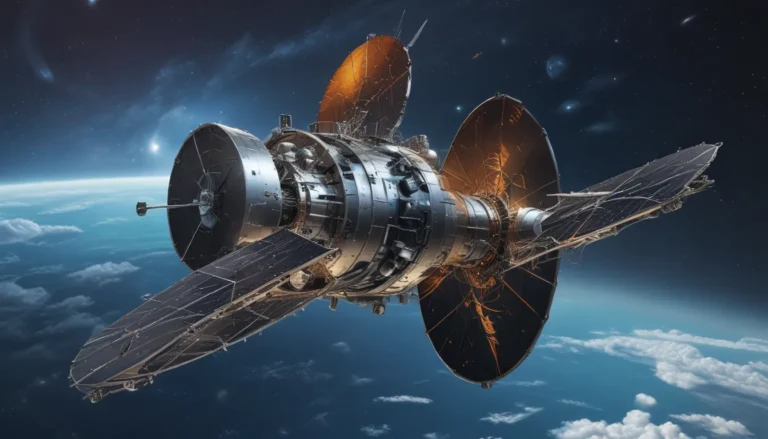The pictures we use in our articles might not show exactly what the words say. We choose these pictures to make you interested in reading more. The pictures work together with the words but don’t take their place. The words still tell you the important facts.
Space elevators have long been a subject of fascination for science fiction enthusiasts and space exploration enthusiasts alike. These remarkable structures, though currently hypothetical, offer a potential groundbreaking way to transport people and cargo into space without relying on expensive rocket launches. In this article, we will delve into the enigmatic world of space elevators and uncover 11 fascinating facts about them. From the incredible materials used to build them to the potential they hold for revolutionizing space exploration, these facts shed light on the possibilities and challenges associated with this innovative concept. Join us on a journey through the realms of science fiction and scientific possibility to explore the mysteries surrounding space elevators.
Key Takeaways:
- Space elevators, first envisioned in 1895, have the potential to make space travel more affordable and accessible by utilizing super-strong carbon nanotubes for transporting payloads without costly rocket launches.
- The development of a space elevator would require advances in materials science and robotics, paving the way for potential lunar space elevators for future missions.
The Origins of the Space Elevator:
The concept of a space elevator was first proposed by Russian scientist Konstantin Tsiolkovsky in 1895. Tsiolkovsky envisioned a tall tower extending into space with a counterweight at the top and a cable extending to the Earth’s surface. This visionary idea laid the foundation for future discussions and developments surrounding space elevators.
The Miracle Material: Carbon Nanotubes:
At the core of a space elevator lies a tremendously strong and lightweight material known as carbon nanotubes. These nanotubes boast a tensile strength several times greater than steel, making them an ideal choice for supporting the weight of an elevator reaching into space. The development and utilization of carbon nanotubes are crucial for the realization of space elevator technology.
Revolutionizing Space Travel:
The potential impact of a fully operational space elevator cannot be understated. It could significantly reduce the cost of space travel, making it more accessible and opening up new avenues for exploration and colonization. By enabling payloads to be transported to orbit without the need for costly rocket launches, a space elevator has the potential to revolutionize the economics of space travel.
The International Space Elevator Consortium (ISEC):
To promote the development and realization of a space elevator, the International Space Elevator Consortium (ISEC) was established. This organization brings together scientists, engineers, and enthusiasts from around the globe to collaborate on research and development efforts aimed at advancing space elevator technology. Through the collective efforts of ISEC, progress continues to be made towards making space elevators a reality.
The Engineering Challenges:
Building a space elevator presents a monumental engineering challenge, necessitating advancements in materials science, robotics, and space exploration technologies. Overcoming these challenges would require a coordinated effort from multiple nations and organizations to address the technical and logistical hurdles associated with constructing a space elevator.
Lunar Space Elevators:
In addition to Earth-based space elevators, there are proposed designs for lunar space elevators. These lunar elevators could facilitate transportation from the Moon’s surface to lunar orbit, enabling future lunar missions and serving as a stepping stone for further space exploration endeavors.
Capturing the Imagination:
The idea of a space elevator has captured the imagination of science fiction writers and served as a prominent theme in various novels and movies. From Arthur C. Clarke’s “The Fountains of Paradise” to films like “Interstellar,” the concept of a space elevator has sparked numerous artistic creations, reflecting the allure and intrigue of this futuristic transportation system.
In conclusion, the concept of a space elevator offers a tantalizing glimpse into a future where space travel becomes more accessible and efficient than ever before. While the technology required to build a functional space elevator is still in development, the progress made thus far is promising. With ongoing research and development, we may one day witness the realization of this visionary transportation system, unlocking new possibilities for exploration and colonization in space. As we continue to push the boundaries of human innovation and understanding, the concept of a space elevator serves as a testament to the limitless possibilities of the universe.
FAQs:
Q: What is a space elevator?
A: A space elevator is a theoretical transportation system consisting of a long cable extending from the Earth’s surface into space, enabling the transportation of payloads and humans without the need for rockets.
Q: How does a space elevator work?
A: A space elevator operates based on the principle of a counterweight in space, such as a satellite, balancing the tension in the cable. Elevator cars ascend and descend the cable using a combination of mechanical and electrical systems.
Q: What are the benefits of a space elevator?
A: A space elevator could significantly reduce the cost and energy required for launching objects into space, enabling more affordable space missions, facilitating the construction of large structures in space, and serving as a gateway for future space exploration endeavors.
Q: What are the challenges of building a space elevator?
A: The construction of a space elevator presents various technical challenges, including designing materials strong enough to support the cable, addressing stability and oscillation issues, and developing safe transportation systems for passengers and cargo.
Q: Are there any working space elevators?
A: Currently, there are no operational space elevators. However, ongoing research and development efforts aim to overcome the challenges involved in making a functional space elevator a reality.
Q: How long would a space elevator cable be?
A: The length of a space elevator cable would depend on the desired final destination, potentially ranging from a few hundred kilometers to tens of thousands of kilometers, extending beyond Earth’s geostationary orbit.
As we continue to explore the wonders of space and push the boundaries of human innovation, the concept of a space elevator stands as a beacon of possibility in the vast expanse of the cosmos. Join us on this extraordinary journey of discovery and imagination as we dream of a future where the stars are within reach, thanks to the marvels of space elevator technology.






